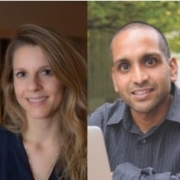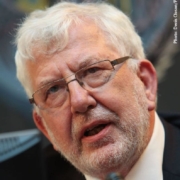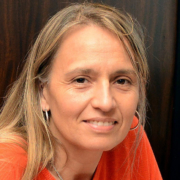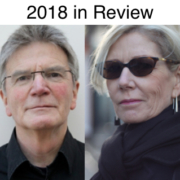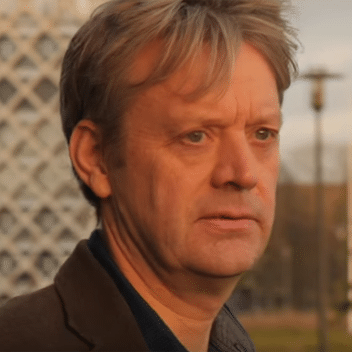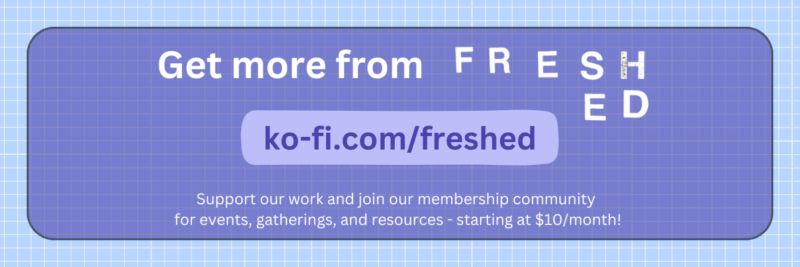What are the possible futures presupposed within the organization of refugee education worldwide? Do the understood purposes of refugee education align at the global, national and school levels?
My guest today is Sarah Dryden-Peterson, an Associate Professor at the Harvard Graduate School of Education who has been researching refugee education for 15 years. Together with Elizabeth Adelman, Michelle Bellino, and Vidur Chopra, she has recently co-authored an article for the journal Sociology of Education that looks at the purposes of refugee education today. Sarah and her colleagues argue that quality refugee education must further a sense of belongingness.
Citation: Dryden-Peterson, Sarah, interview with Will Brehm, FreshEd, 181, podcast audio, November 18, 2019. https://freshedpodcast.com/sarah-dryden-peterson/
Will Brehm 2:30
Sarah Dryden-Peterson, welcome back to FreshEd.
Sarah Dryden-Peterson 2:33
Thanks so much, Will. It is great to be on your show.
Will Brehm 2:36
So, there has been a lot of talk about futures lately. We actually recently did a whole show on UNESCO’s new project on “The Futures of Education: Learning to Become,” this new idea that they’re promoting. So, when it comes to refugees, and particularly refugee education, how can we even start thinking about the idea of futures?
Sarah Dryden-Peterson 2:59
It is such a great question, and really one that preoccupies our work. I love the show that you did with Noah Sobe, and I am really excited about this commission’s work. And it does, like you’re saying, really resonate with the work that we’ve been doing on futures within refugee education. I was thinking about it, and the last time I was on your show, we were talking about unknowable futures and this uncertainty that is embedded within the experience of being a refugee. And I think, like UNESCO’s project, our work has really tried to embrace this uncertainty of futures and think about ways in which education can contribute to future making despite the uncertainty. I do think that within refugee education, there are some quite specific parameters that are important to keep in mind when we think about the futures for which education prepares young people. Particularly because most national education systems quite explicitly prepare young people for a future that is connected to that nation-state. So, national governments invest in education with the promise of returns of economic growth and social and civic development really to accrue to that nation-state. But, of course, refugees are, by definition, non-citizens. And so, the specificity of their futures, especially in terms of their physical location and where within a nation-state they might be, is uncertain and unpredictable. And so, my co-authors and I – Elizabeth Adelman, Michelle Bellino, and Vidur Chopra – we really in this paper try to think about four possible futures for refugees: a future of resettlement; a future of return; a future of integration; and a future of transnationalism. We observe that how children, families, and teachers, as well as others involved in education, really think about the purposes of refugee education in terms of the future that they imagine. And the kinds of refugee education they design really depend on those futures.
Will Brehm 5:00
So, what sort of purposes of refugee education do these different futures presuppose, in a sense? I mean, these different imaginations of where refugees will end up in the future would, I guess, determine how we then or a nation-state or an NGO or whatever, organizes education for refugees?
Sarah Dryden-Peterson 5:25
That is right. And so, in this 14-country study, we see different nation-states orienting refugee education in different ways, depending on the dominant view of what the future might be. So in a situation where the future is imagined as resettlement – meaning to a distant, usually high-income country – refugee education usually takes place such that refugee young people are able to develop some skills that would be transferable to a new context, and develop language skills that would be useful in that new context. But of course, the future of resettlement is quite small and unlikely for most refugees, with only 1% of refugees having that kind of opportunity open to them. So, there’s really quite a limited amount of refugee education that focuses on that future.
Will Brehm 6:17
So, this would be something like a refugee that, you know, leaves a particular country for whatever reason, and claims refugee status, but then ends up getting resettled in a third country. And the idea would be that that person then lives there for the rest of their life and becomes a citizen.
Sarah Dryden-Peterson 6:38
That is right and becomes a citizen and has that different certainty about what the future would be in resettlement because of that pathway to citizenship.
Will Brehm 6:47
But this is a very, as you said, small percentage of refugees actually have this future possibility of resettlement. So, what about return, the future of return?
Sarah Dryden-Peterson 6:56
So, a future of return has really been, in many ways, the dominant way of thinking about what refugee education is for, what the purposes of refugee education are over historical time, with this idea that, really, most refugee young people and their families would look for a future of return if that future of return were possible. But I think what is different right now and is important as we think about refugee education is that so many of the conflicts that young people are fleeing are protracted. So that a refugee young person living in exile can expect to live outside their country of origin for an average of 10 to 25 years, which is very different than it was in the 1990s. So, this future of return, while desirable in many ways, is often unlikely. Yet, preparing for a future of return often requires quite different kind of education than would preparing for a future of integration, for example. So if a refugee were to be certain of a future return to a country of origin, it would be quite clear what language of instruction would be useful, the kind of credentials that could transfer to that country of origin system, and there would be the potential for more continuity, again with that certainty of the possibility.
Will Brehm 8:19
But it is not that certain. I mean, 10 to 25 years, this is incredible, right. So you can be a child and basically have your entire childhood in a third country, where, you know, you are being educated, in a way, to go back to a country that you have no connection to by that point, after 25 years.
Sarah Dryden-Peterson 8:38
That is right. That is right. So, we talk about this future of return. But the reality for many young people, even if they were to return, it is actually not a return. It is a journey to a place where they have never lived themselves because of this protracted nature of being displaced and living as a refugee.
Will Brehm 8:58
So, integration becomes perhaps a future that is more realistic.
Sarah Dryden-Peterson 9:03
So that’s been a real shift within thinking on refugee education within the past ten years or so, with this idea that if the reality of exile is at least medium-term, but often long-term, that thinking about education that prepares young people for a future within the host country is an important way in which education could help prepare young people for a future. So, a future of integration would involve enabling labor market participation and a sense of belonging through the kinds of education that are available. And this idea of permanence, so that a future would be built together with nationals and in that place. One of the distinctions I think we try to make in this paper that’s important when thinking about policy, too, is that the idea of inclusion and the idea of integration are really being used quite differently within discussions on refugee education. So “inclusion” could be temporary and really could be just about structures of access to school. So, including refugees within a school. But “integration” really implies a much longer-term commitment to this idea of building a future together and to social belonging, which is the crux of this paper.
Will Brehm 10:22
Right. So, okay, so, there’s refugees are being included in national systems of education, but not necessarily integrated into those systems.
Sarah Dryden-Peterson 10:33
That is right. That’s what we really find in this paper: that there has been widespread movement toward including refugees in national education systems over the past six or seven years, and yet that inclusion does not necessarily mean the social process of integration and working toward a sense of belonging.
Will Brehm 10:55
And so, you also have this other idea, what you call in the paper “transnationalism” and this future of transnationalism. Can you explain what that is, and how some refugee education, the purpose of refugee education, presupposes this idea of transnationalism?
Sarah Dryden-Peterson 11:13
This future of transnationalism really comes out of what we hear from refugee young people in particular. The United Nations High Commissioner for Refugees has long defined what they call three durable solutions, which are, in fact, somewhat like thinking about the futures, which are these futures of resettlement, return, and integration that we’ve just talked about. But we find that most refugee young people really imagine a future of what we call “transnationalism” that’s not geographically bounded, and that where, in fact, opportunities might be created through mobility rather than limited through mobility and through borders, which is often the experience of refugees. And I think part of this idea of needing to conceptualize a future of transnationalism stems from the uncertainty of any of these other futures and entails some need to think about flexibility and adaptability within refugee education, as well as some of the structural dimensions of national education systems that, in fact, are not transnational, and really do provide certification and provide content-specific education that is what young refugees find often only relevant within a particular nation-state.
Will Brehm 12:29
So, when it comes to these different purposes of education, and that obviously then gets translated into particular policies and practices of education, of refugee education, you know, I guess, who’s deciding? You know, what are the actors, who are the actors involved in different cases, say at the global level, deciding how we should even imagine a future of refugees and then translate that into policy and practice? So, who, in other words, are the actors, sort of thinking through some of these issues?
Sarah Dryden-Peterson 13:03
We have really tried to structure this paper – and I think this is important methodologically – as a vertical analysis. So looking at actors at a global level, at a national level, at a local level, and really trying to tease out some of the differences in the way that the purposes of refugee education are viewed at these different levels. So at a global level, there are multiple actors involved in refugee education, including UN agencies like the United Nations High Commissioner for Refugees, and UNICEF, as well as Education Cannot Wait, a host of international NGOs that have a long history of working on refugee education, as well as bilateral donors that are committed to funding refugee education either through some of these multilaterals and NGOs or in direct funding to nation-states. And I think for all of these organizations, increasingly it is becoming evident the need to work in collaboration across the kind of organization, which is not always the norm in humanitarian situations. But as we see this movement toward including refugees in national education systems, this real shift toward a longer-term thinking and toward development, and the kinds of collaborations that are needed in that kind of setting.
Will Brehm 14:19
Okay, so that is the global level. What about at the different national levels in these different countries? How is refugee education being imagined, and you know, the future of refugees being imagined?
Sarah Dryden-Peterson 14:31
At the national level, we really see this policy of inclusion looking quite different in different contexts. And I think for this particular refugee education policy of inclusion, it was really designed to be adapted to national contexts. And as a result, we see different kinds of models of inclusion developing. So, in Malaysia and Bangladesh, for example, we really don’t see inclusion taking place. Governments have not adopted a policy of inclusion, so that refugees and nationals attend separate schools, and refugee education is in these particular cases quite informal, with lack of certainty around what certification options might be. But in other countries, we’ve seen a real rapid uptake of this policy of inclusion since the first UNHCR strategy in 2012 put it forward. So in places where refugees live in camp settings, such as in Kenya, we see an inclusion model developed where refugees use the Kenyan curriculum and use English and Kiswahili as the languages of instruction, even though refugee and national children are isolated from each other because geographically they live in different spaces within the country. So, they don’t attend school together, but there are structural elements of inclusion in terms of curriculum and certification. Yet other places, like in the example of Lebanon, we see a model of inclusion that involves refugee children attending the same physical schools as nationals with many of the same teachers. They use the same curriculum, the Lebanese national curriculum, Lebanese national examination system, but at a different time of day in a double shift. So Lebanese students come to school in the morning, and refugees in the afternoon. It is only in few places, and not consistent across national contexts, that we see refugees and nationals actually attending school together at the same time. And usually, that is in urban areas where there may be smaller populations of refugees or long-standing populations that are quite integrated with national populations.
Will Brehm 16:40
So in a sense, using these two examples that you provided: Lebanon, in a way, would be more closely connected to this idea of a future of integration, whereas in Kenya, it’s much more about a future of inclusion; or you know, it’s not necessarily really integration since, you said, they’re in two different physical spaces.
Sarah Dryden-Peterson 17:01
And I think this is a really open question within refugee education of what can enable integration and not just inclusion. So even in the case of Lebanon, there is quite substantial separation between national students who attend school in the morning and refugees who come in the afternoon. In our work there, particularly with grade nine students, we see a lack of relationships, a lack of possibility for relationships to develop between refugee students and national students. There is a short gap in the middle of the day so that, physically, the students don’t cross paths within the schools. And quite a tight sense of the school really belonging to the national students, and the refugee students just being there in the afternoon to have some opportunity for learning. But as one of our participants said, no opportunity to become established. And I think that, again, it provides this example of where inclusion can be a strategy towards providing access to education and can provide this access to the structures of what a quality education might involve. But very little focus on what it means to develop relationships across long-time residents and refugees and this process of social integration and belonging.
Will Brehm 18:22
Right. So, one of the main purposes of education being this idea of social cohesion. Not only preparing someone for the labor market but actually being connected to some national society or even local society. And so, it does bring up a very interesting point about what is even the meaning of quality education when it comes to refugee education.
Sarah Dryden-Peterson 18:46
I think that is right. And you mentioned both labor market participation and social cohesion here. And across our 14-country study, we really hear these dimensions of education being described at almost all levels by teachers, by students, by families, by international organization actors, as real purposes of education. And yet real tensions in refugee education as to whether it is even possible to think about those dimensions of quality. So, in most places, refugees don’t have the right to work. So, this idea of education as a preparation for labor market participation is not guaranteed. And what we often see is young people very cognizant of this disconnect between what they’re being asked to do in school, how they imagine that preparation will assist them in building a livelihood, and yet knowing what the laws are in place that will prevent that from happening. And also, in terms of social cohesion, in many places, including most nation-states that host refugees, there are long histories of conflict and divisions so that social cohesion, as it is taught, particularly within national curriculum and within national education systems, is often about a fairly tight, standard view of what national unity might look like. And that often can be quite politically, ethnically, linguistically exclusive, not only for refugees who can’t see themselves within that national narrative but also of marginalized national students. And there’s also this idea that refugees, particularly in places that continue to experience conflict and division, might disrupt very fragile social cohesion, which can result in even more forceful standardizing of curriculum for the sake of control and legitimate goals of preserving unity, when it is fragile that way.
Will Brehm 20:50
Is there a good example of a particular country where that phenomenon is found?
Sarah Dryden-Peterson 20:55
We do see this in our ongoing work in Lebanon now. And I think that this idea that refugee education is often situated within marginalized national populations is really important as we think about the idea of quality. And I think, in particular, it points to areas within national education that are often overlooked. And the kind of possibility of imagining any of these futures that we’re talking about when access to poor quality schooling is the norm. So in Lebanon, for example, refugees have access to the second shift that I was describing in public schools, but only 30% of national students attend public schools, and those with other options will choose other options outside of these public schools. And so, there’s already this sense that a future of integration would be a future of integration into an education system and into a level of society that is not desirable by nationals and is also not something that refugees are looking for.
Will Brehm 22:04
And so, they would continue to be marginalized, even if integrated?
Sarah Dryden-Peterson 22:08
In many of the places where refugees are included in national schools, in fact, what we find in most places, is that the quality of education is not high for nationals either. And so while the promise of including refugees in national education systems often comes back to this idea that it might be of higher quality within an already established system with trained teachers, with a sequenced curriculum, that the particular places in which refugees are being included are often within countries that struggle broadly to provide quality education, or within regions of countries, or areas of cities, where the quality of schooling is unequal and in fact, poor quality schooling that refugees are not seeking out either.
Will Brehm 22:53
So, I mean, it seems as if you are beginning to differentiate the idea of “integration”, which, sort of, on the surface sounds quite good. But actually, it’s more … and I think you use this term before in our conversation: of “belongingness”. So, you know, what is this difference between belongingness and integration?
Sarah Dryden-Peterson 23:12
I think this really is at the crux of what we get at in this paper. And I think that what we see in the model of including refugees within national education systems is a very important focus on the structures of inclusion. So, as I was saying, the teachers, the curriculum, the certification, but much less focus on what these relational elements of a longer-term integration would mean. And I think it’s important to distinguish here: in almost no cases do we hear from the various actors involved in refugee education that long-term permanent integration is the goal. Even though we know that crises are protracted, in the end, most refugee young people would elect to pursue a future of return or a future of transnationalism. And yet wanting to keep open this possibility of being able to be an active, productive contributor to the society in which they live, which for the immediate term, is a country of exile. So, this idea of belonging really comes back to these relational dimensions: the opportunity to build relationships, to build understanding across lines of difference. And I think that the models of inclusion that we have found within most countries simply don’t even allow the contact among young people to foster this kind of relational dimensions. And even when they do, in cases where refugees and nationals attend schools together, there’s often very little focus within curriculum and pedagogy on these dimensions of relationship that might allow for working through some of the conflicts or the perceived threats that may or may not exist, but when you don’t have that opportunity to know someone as an individual are very hard to overcome.
Will Brehm 25:07
Is there any example where, you know, refugee education was actually able to create such a sense of belongingness?
Sarah Dryden-Peterson 25:16
It’s been hard for us to find large-scale examples of this kind of relational integration and belonging. But this idea of belonging has emerged as so important from the work that we’ve been doing that it’s a real focus of our current work. And right now, we’re launching a project that we’re calling the Together Project and studying individual schools in multiple national contexts with large refugee populations that we’re finding to be extraordinarily successful at building welcoming communities among long-time residents and newcomers. And it’s really our hope in this project to be able to identify some of the pedagogies and the processes – these real “how” questions, not the “what” questions – of what schools, teachers, students, families are doing to actively build communities in which there’s a sense of welcome. And I think that this is even more important to me because what we hear from young people and from teachers in all of these national context in which we’ve been working is that they’re looking for ideas of how to do this. It is not a sense of not finding belonging and not finding people who are seeking out the mechanisms to create that. In fact, it would be the number one request that we would hear from teachers, are for sharing ideas about how they could better do their work to create this kind of inclusive communities. So, hoping that through this project, we might be able to identify ways in which there are possibilities within schools that everyone could imagine a future, even if those futures are divergent. Coming back to this idea that it is not just one future, but maybe multiple futures pursued within any form of education.
Will Brehm 27:01
It’s really quite fascinating. I mean, it does remind me of some of the work of Benedict Anderson and really pushing issues of imagined communities a bit further. It’s imagined future communities that are, you know, in many ways, diverse and transnational. And it really sort of is this new idea, I think, that has to be sort of theorized and, you know, researched quite heavily.
Sarah Dryden-Peterson 27:26
I think that is right. And it brings me back to thinking about the history of refugee education to in the post-war, and particularly through the 60s and 70s, refugee education was really a very localized endeavor. So communities creating their own schools to educate refugees, often with this real sense of self-determination, because many refugees were in exile due to independence struggles, and a very clear sense that the future for which refugees were being prepared would be to return to a country of origin and take up leadership roles in a post-independence place. And we saw a lot of transnationalism at that time too, which I think is resurfacing as really critical as we think about what these imagined communities are that may actually look quite different from what we see now, and how education can, in fact, attempt to remake these kinds of communities and allow individuals to imagine what they might look like. And hopefully, over the long run, break down some of the structural barriers, particularly around abilities to migrate and abilities to work and to actually tangibly take up the rights that we think of as universal to be able to pursue these futures.
Will Brehm 28:48
And so, you know, given your research and your analysis of the history plus this Together Project that you’re beginning to work on, you know, what sort of policy proposals have you and your team sort of begun to think about, or realize, are really important for successful refugee education that sort of does contribute to this idea of belongingness?
Sarah Dryden-Peterson 29:15
I think what comes out of our work is the real need to focus on more of the relational dimensions of education. So, making sure that we do think about quality not just as that form of access to a national system, but what actually happens in classrooms in terms of curriculum, in terms of pedagogy. And the new UNHCR strategy, Inclusion 2030, really advocates for this shift in thinking more about the daily teaching and learning that goes on. But they’re very hard challenges, as we all know, and particularly within national education systems that struggle to meet the needs of national students. And I think what comes out for us quite heavily is this is a real collective challenge. That, in fact, when we think about the purposes of refugee education, what we expose are areas in which the global movement to provide quality education for all, in fact, has obviously left out many national students. And the places in which refugees are attempting to access education are also places where nationals don’t have access to that kind of a quality education. So, thinking about refugee education not in isolation, but as the real collective challenge of ensuring that all marginalized young people have access to a quality education. And one of the initiatives that we’re launching, connected to this, is called refugee REACH: research, education, and action for change and hope. This is an initiative of the Harvard Graduate School of Education, and we’re really trying to think about ways to connect researchers, policymakers, and educators in collective thinking about quality education and building welcoming communities in settings of migration and displacement. We’ll be launching this initiative next month to coincide with the Global Refugee Forum, and one of the elements of it that I’m particularly excited about is a series of virtual conversations on some of these critical dilemmas in refugee education, research, in policy, and in practice that we’ve been talking about today. My hope is really that collectively, through these ongoing conversations, that we can develop ways to educate so education doesn’t stand in the way of refugees’ futures, but instead can create concrete spaces for weaving together the success of all of our futures.
Will Brehm 31:40
Well, Sarah Dryden-Peterson, thank you so much for joining FreshEd again. Best of luck in the conference next month, and please come back on and share some of these… the learning that happens with these different projects that you have going on. So, thank you very much again for joining.
Sarah Dryden-Peterson 31:56
Thanks so much, Will.
Have useful resources related to this show? Please send them to info@freshedpodcast.com
Futures of Refugee Education


